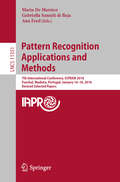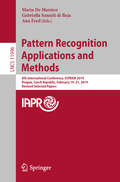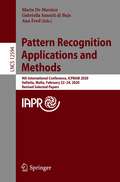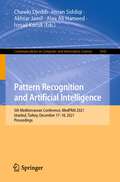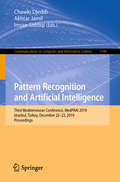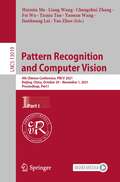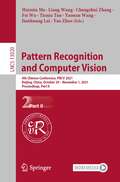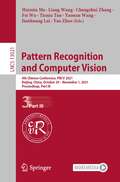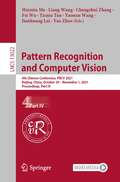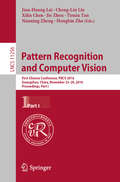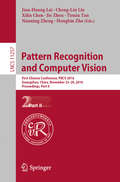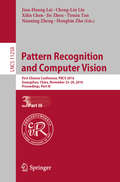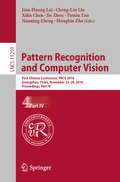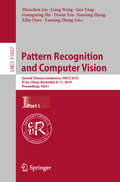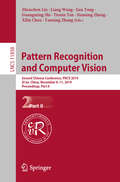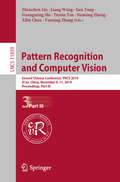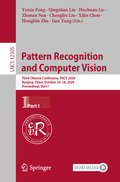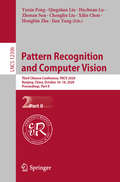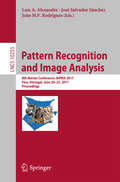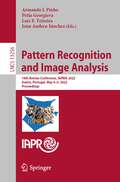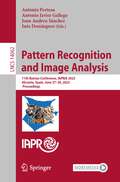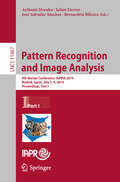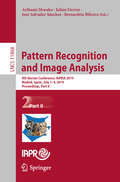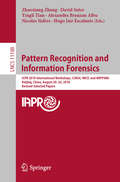- Table View
- List View
Pattern Recognition Applications and Methods: 7th International Conference, ICPRAM 2018, Funchal, Madeira, Portugal, January 16-18, 2018, Revised Selected Papers (Lecture Notes in Computer Science #11351)
by Ana Fred Maria De Marsico Gabriella Sanniti di BajaThis book contains revised and extended versions of selected papers from the 7th International Conference on Pattern Recognition, ICPRAM 2018, held in Porto, Portugal, in January 2018. The 10 full papers presented were carefully reviewed and selected from 102 initial submissions.The core of ICPRAM is intended to include theoretical studies yielding new insights in Pattern Recognition methods, as well as experimental validation and concrete application of Pattern Recognition techniques to real-world problems.
Pattern Recognition Applications and Methods: 8th International Conference, ICPRAM 2019, Prague, Czech Republic, February 19-21, 2019, Revised Selected Papers (Lecture Notes in Computer Science #11996)
by Ana Fred Maria De Marsico Gabriella Sanniti di BajaThis book contains revised and extended versions of selected papers from the 8th International Conference on Pattern Recognition, ICPRAM 2019, held in Prague, Czech Republic, in February 2019. The 25 full papers presented together 52 short papers and 32 poster sessions were carefully reviewed and selected from 138 initial submissions. Contributions describing applications of Pattern Recognition techniques to real-world problems, interdisciplinary research, experimental and/or theoretical studies yielding new insights that advance Pattern Recognition methods are especially encouraged.
Pattern Recognition Applications and Methods: 9th International Conference, ICPRAM 2020, Valletta, Malta, February 22–24, 2020, Revised Selected Papers (Lecture Notes in Computer Science #12594)
by Ana Fred Maria De Marsico Gabriella Sanniti di BajaThis book contains revised and extended versions of selected papers from the 9th International Conference on Pattern Recognition, ICPRAM 2020, held in Valletta, Malta, in February 2020. The 7 full papers presented were carefully reviewed and selected from 102 initial submissions. The papers describe applications of pattern recognition techniques to real-world problems, interdisciplinary research, experimental and theoretical studies yielding new insights that advance pattern recognition methods are especially encouraged.
Pattern Recognition and Artificial Intelligence: 5th Mediterranean Conference, MedPRAI 2021, Istanbul, Turkey, December 17–18, 2021, Proceedings (Communications in Computer and Information Science #1543)
by Chawki Djeddi Akhtar Jamil Imran Siddiqi Alaa Ali Hameed İsmail KucukThis book constitutes the refereed proceedings of the 5th Mediterranean Conference on Pattern Recognition and Artificial Intelligence, MedPRAI 2021, held in Istanbul, Turkey, in December 2021. Due to the COVID-19 pandemic, MedPRAI 2021 was held fully online.The 28 revised full papers and 4 short papers presented were thoroughly reviewed and selected from 72 submissions. The papers are covering the topics of recent advancements in different areas of pattern recognition and artificial intelligence, such as statistical, structural and syntactic pattern recognition, machine learning, data mining, neural networks, computer vision, multimedia systems, information retrieval, etc.
Pattern Recognition and Artificial Intelligence: Third Mediterranean Conference, MedPRAI 2019, Istanbul, Turkey, December 22–23, 2019, Proceedings (Communications in Computer and Information Science #1144)
by Chawki Djeddi Akhtar Jamil Imran SiddiqiThis book constitutes the refereed proceedings of the Third Mediterranean Conference on Pattern Recognition and Artificial Intelligence, MedPRAI 2019, held in Istanbul, Turkey, in December 2019.The 18 revised full papers and one short paper presented were carefully selected from 54 submissions. The papers are covering the topics of recent advancements in different areas of pattern recognition and artificial intelligence, such as statistical, structural and syntactic pattern recognition, machine learning, data mining, neural networks, computer vision, multimedia systems, information retrieval, etc.
Pattern Recognition and Computer Vision: 4th Chinese Conference, PRCV 2021, Beijing, China, October 29 – November 1, 2021, Proceedings, Part I (Lecture Notes in Computer Science #13019)
by Liang Wang Yao Zhao Tieniu Tan Fei Wu Changshui Zhang Huimin Ma Yaonan Wang Jianhuang LaiThe 4-volume set LNCS 13019, 13020, 13021 and 13022 constitutes the refereed proceedings of the 4th Chinese Conference on Pattern Recognition and Computer Vision, PRCV 2021, held in Beijing, China, in October-November 2021. The 201 full papers presented were carefully reviewed and selected from 513 submissions. The papers have been organized in the following topical sections: Object Detection, Tracking and Recognition; Computer Vision, Theories and Applications, Multimedia Processing and Analysis; Low-level Vision and Image Processing; Biomedical Image Processing and Analysis; Machine Learning, Neural Network and Deep Learning, and New Advances in Visual Perception and Understanding.
Pattern Recognition and Computer Vision: 4th Chinese Conference, PRCV 2021, Beijing, China, October 29 – November 1, 2021, Proceedings, Part II (Lecture Notes in Computer Science #13020)
by Liang Wang Yao Zhao Tieniu Tan Fei Wu Changshui Zhang Huimin Ma Yaonan Wang Jianhuang LaiThe 4-volume set LNCS 13019, 13020, 13021 and 13022 constitutes the refereed proceedings of the 4th Chinese Conference on Pattern Recognition and Computer Vision, PRCV 2021, held in Beijing, China, in October-November 2021. The 201 full papers presented were carefully reviewed and selected from 513 submissions. The papers have been organized in the following topical sections: Object Detection, Tracking and Recognition; Computer Vision, Theories and Applications, Multimedia Processing and Analysis; Low-level Vision and Image Processing; Biomedical Image Processing and Analysis; Machine Learning, Neural Network and Deep Learning, and New Advances in Visual Perception and Understanding.
Pattern Recognition and Computer Vision: 4th Chinese Conference, PRCV 2021, Beijing, China, October 29 – November 1, 2021, Proceedings, Part III (Lecture Notes in Computer Science #13021)
by Liang Wang Yao Zhao Tieniu Tan Fei Wu Changshui Zhang Huimin Ma Yaonan Wang Jianhuang LaiThe 4-volume set LNCS 13019, 13020, 13021 and 13022 constitutes the refereed proceedings of the 4th Chinese Conference on Pattern Recognition and Computer Vision, PRCV 2021, held in Beijing, China, in October-November 2021. The 201 full papers presented were carefully reviewed and selected from 513 submissions. The papers have been organized in the following topical sections: Object Detection, Tracking and Recognition; Computer Vision, Theories and Applications, Multimedia Processing and Analysis; Low-level Vision and Image Processing; Biomedical Image Processing and Analysis; Machine Learning, Neural Network and Deep Learning, and New Advances in Visual Perception and Understanding.
Pattern Recognition and Computer Vision: 4th Chinese Conference, PRCV 2021, Beijing, China, October 29 – November 1, 2021, Proceedings, Part IV (Lecture Notes in Computer Science #13022)
by Liang Wang Yao Zhao Tieniu Tan Fei Wu Changshui Zhang Huimin Ma Yaonan Wang Jianhuang LaiThe 4-volume set LNCS 13019, 13020, 13021 and 13022 constitutes the refereed proceedings of the 4th Chinese Conference on Pattern Recognition and Computer Vision, PRCV 2021, held in Beijing, China, in October-November 2021. The 201 full papers presented were carefully reviewed and selected from 513 submissions. The papers have been organized in the following topical sections: Object Detection, Tracking and Recognition; Computer Vision, Theories and Applications, Multimedia Processing and Analysis; Low-level Vision and Image Processing; Biomedical Image Processing and Analysis; Machine Learning, Neural Network and Deep Learning, and New Advances in Visual Perception and Understanding.
Pattern Recognition and Computer Vision: First Chinese Conference, PRCV 2018, Guangzhou, China, November 23-26, 2018, Proceedings, Part I (Lecture Notes in Computer Science #11256)
by Tieniu Tan Jie Zhou Cheng-Lin Liu Xilin Chen Jian-Huang Lai Nanning Zheng Hongbin ZhaThe four-volume set LNCS 11056, 110257, 11258, and 11073 constitutes the refereed proceedings of the First Chinese Conference on Pattern Recognition and Computer Vision, PRCV 2018, held in Guangzhou, China, in November 2018. The 179 revised full papers presented were carefully reviewed and selected from 399 submissions. The papers have been organized in the following topical sections: Part I: Biometrics, Computer Vision Application. Part II: Deep Learning. Part III: Document Analysis, Face Recognition and Analysis, Feature Extraction and Selection, Machine Learning. Part IV: Object Detection and Tracking, Performance Evaluation and Database, Remote Sensing.
Pattern Recognition and Computer Vision: First Chinese Conference, PRCV 2018, Guangzhou, China, November 23-26, 2018, Proceedings, Part II (Lecture Notes in Computer Science #11257)
by Tieniu Tan Jie Zhou Cheng-Lin Liu Xilin Chen Jian-Huang Lai Nanning Zheng Hongbin ZhaThe four-volume set LNCS 11056, 110257, 11258, and 11073 constitutes the refereed proceedings of the First Chinese Conference on Pattern Recognition and Computer Vision, PRCV 2018, held in Guangzhou, China, in November 2018. The 179 revised full papers presented were carefully reviewed and selected from 399 submissions. The papers have been organized in the following topical sections: Part I: Biometrics, Computer Vision Application. Part II: Deep Learning. Part III: Document Analysis, Face Recognition and Analysis, Feature Extraction and Selection, Machine Learning. Part IV: Object Detection and Tracking, Performance Evaluation and Database, Remote Sensing.
Pattern Recognition and Computer Vision: First Chinese Conference, PRCV 2018, Guangzhou, China, November 23-26, 2018, Proceedings, Part III (Lecture Notes in Computer Science #11258)
by Tieniu Tan Jie Zhou Cheng-Lin Liu Xilin Chen Jian-Huang Lai Nanning Zheng Hongbin ZhaThe four-volume set LNCS 11056, 110257, 11258, and 11073 constitutes the refereed proceedings of the First Chinese Conference on Pattern Recognition and Computer Vision, PRCV 2018, held in Guangzhou, China, in November 2018. The 179 revised full papers presented were carefully reviewed and selected from 399 submissions. The papers have been organized in the following topical sections: Part I: Biometrics, Computer Vision Application. Part II: Deep Learning. Part III: Document Analysis, Face Recognition and Analysis, Feature Extraction and Selection, Machine Learning. Part IV: Object Detection and Tracking, Performance Evaluation and Database, Remote Sensing.
Pattern Recognition and Computer Vision: First Chinese Conference, PRCV 2018, Guangzhou, China, November 23-26, 2018, Proceedings, Part IV (Lecture Notes in Computer Science #11259)
by Tieniu Tan Jie Zhou Cheng-Lin Liu Xilin Chen Jian-Huang Lai Nanning Zheng Hongbin ZhaThe four-volume set LNCS 11056, 110257, 11258, and 11073 constitutes the refereed proceedings of the First Chinese Conference on Pattern Recognition and Computer Vision, PRCV 2018, held in Guangzhou, China, in November 2018. The 179 revised full papers presented were carefully reviewed and selected from 399 submissions. The papers have been organized in the following topical sections: Part I: Biometrics, Computer Vision Application. Part II: Deep Learning. Part III: Document Analysis, Face Recognition and Analysis, Feature Extraction and Selection, Machine Learning. Part IV: Object Detection and Tracking, Performance Evaluation and Database, Remote Sensing.
Pattern Recognition and Computer Vision: Second Chinese Conference, PRCV 2019, Xi’an, China, November 8–11, 2019, Proceedings, Part I (Lecture Notes in Computer Science #11857)
by Liang Wang Tieniu Tan Jian Yang Yanning Zhang Xilin Chen Nanning Zheng Zhouchen Lin Guangming ShiThe three-volume set LNCS 11857, 11858, and 11859 constitutes the refereed proceedings of the Second Chinese Conference on Pattern Recognition and Computer Vision, PRCV 2019, held in Xi’an, China, in November 2019. The 165 revised full papers presented were carefully reviewed and selected from 412 submissions. The papers have been organized in the following topical sections: Part I: Object Detection, Tracking and Recognition, Part II: Image/Video Processing and Analysis, Part III: Data Analysis and Optimization.
Pattern Recognition and Computer Vision: Second Chinese Conference, PRCV 2019, Xi’an, China, November 8–11, 2019, Proceedings, Part II (Lecture Notes in Computer Science #11858)
by Liang Wang Tieniu Tan Jian Yang Yanning Zhang Xilin Chen Nanning Zheng Zhouchen Lin Guangming ShiThe three-volume set LNCS 11857, 11858, and 11859 constitutes the refereed proceedings of the Second Chinese Conference on Pattern Recognition and Computer Vision, PRCV 2019, held in Xi’an, China, in November 2019. The 165 revised full papers presented were carefully reviewed and selected from 412 submissions. The papers have been organized in the following topical sections: Part I: Object Detection, Tracking and Recognition, Part II: Image/Video Processing and Analysis, Part III: Data Analysis and Optimization.
Pattern Recognition and Computer Vision: Second Chinese Conference, PRCV 2019, Xi’an, China, November 8–11, 2019, Proceedings, Part III (Lecture Notes in Computer Science #11859)
by Liang Wang Tieniu Tan Jian Yang Yanning Zhang Xilin Chen Nanning Zheng Zhouchen Lin Guangming ShiThe three-volume set LNCS 11857, 11858, and 11859 constitutes the refereed proceedings of the Second Chinese Conference on Pattern Recognition and Computer Vision, PRCV 2019, held in Xi’an, China, in November 2019. The 165 revised full papers presented were carefully reviewed and selected from 412 submissions. The papers have been organized in the following topical sections: Part I: Object Detection, Tracking and Recognition, Part II: Image/Video Processing and Analysis, Part III: Data Analysis and Optimization.
Pattern Recognition and Computer Vision: Third Chinese Conference, PRCV 2020, Nanjing, China, October 16–18, 2020, Proceedings, Part I (Lecture Notes in Computer Science #12305)
by Jian Yang Qingshan Liu Zhenan Sun Xilin Chen Huchuan Lu Yuxin Peng Hongbin Zha Chenglin LiuThe three-volume set LNCS 12305, 12306, and 12307 constitutes the refereed proceedings of the Third Chinese Conference on Pattern Recognition and Computer Vision, PRCV 2020, held virtually in Nanjing, China, in October 2020. The 158 full papers presented were carefully reviewed and selected from 402 submissions. The papers have been organized in the following topical sections: Part I: Computer Vision and Application, Part II: Pattern Recognition and Application, Part III: Machine Learning.
Pattern Recognition and Computer Vision: Third Chinese Conference, PRCV 2020, Nanjing, China, October 16–18, 2020, Proceedings, Part II (Lecture Notes in Computer Science #12306)
by Jian Yang Qingshan Liu Zhenan Sun Xilin Chen Huchuan Lu Yuxin Peng Hongbin Zha Chenglin LiuThe three-volume set LNCS 12305, 12306, and 12307 constitutes the refereed proceedings of the Third Chinese Conference on Pattern Recognition and Computer Vision, PRCV 2020, held virtually in Nanjing, China, in October 2020. The 158 full papers presented were carefully reviewed and selected from 402 submissions. The papers have been organized in the following topical sections: Part I: Computer Vision and Application, Part II: Pattern Recognition and Application, Part III: Machine Learning.
Pattern Recognition and Computer Vision: Third Chinese Conference, PRCV 2020, Nanjing, China, October 16–18, 2020, Proceedings, Part III (Lecture Notes in Computer Science #12307)
by Jian Yang Qingshan Liu Zhenan Sun Xilin Chen Huchuan Lu Yuxin Peng Hongbin Zha Chenglin LiuThe three-volume set LNCS 12305, 12306, and 12307 constitutes the refereed proceedings of the Third Chinese Conference on Pattern Recognition and Computer Vision, PRCV 2020, held virtually in Nanjing, China, in October 2020. The 158 full papers presented were carefully reviewed and selected from 402 submissions. The papers have been organized in the following topical sections: Part I: Computer Vision and Application, Part II: Pattern Recognition and Application, Part III: Machine Learning.
Pattern Recognition and Image Analysis
by Luís A. Alexandre José Salvador Sánchez João M. RodriguesThis book constitutes the refereed proceedings of the 8th Iberian Conference on Pattern Recognition and Image Analysis, IbPRIA 2017, held in Faro, Portugal, in June 2017. The 60 regular papers presented in this volume were carefully reviewed and selected from 86 submissions. They are organized in topical sections named: Pattern Recognition and Machine Learning; Computer Vision; Image and Signal Processing; Medical Image; and Applications.
Pattern Recognition and Image Analysis: 10th Iberian Conference, IbPRIA 2022, Aveiro, Portugal, May 4–6, 2022, Proceedings (Lecture Notes in Computer Science #13256)
by Armando J. Pinho Petia Georgieva Luís F. Teixeira Joan Andreu SánchezThis book constitutes the refereed proceedings of the 10th Iberian Conference on Pattern Recognition and Image Analysis, IbPRIA 2022, held in Aveiro, Portugal, in May 2022. The 54 papers accepted for these proceedings were carefully reviewed and selected from 72 submissions. They deal with document analysis; medical image processing; biometrics; pattern recognition and machine learning; computer vision; and other applications.
Pattern Recognition and Image Analysis: 11th Iberian Conference, IbPRIA 2023, Alicante, Spain, June 27–30, 2023, Proceedings (Lecture Notes in Computer Science #14062)
by Joan Andreu Sánchez Antonio Pertusa Antonio Javier Gallego Inês DominguesThis book constitutes the refereed proceedings of the 11th Iberian Conference on Pattern Recognition and Image Analysis, IbPRIA 2023, held in Alicante, Spain, in June 27–30, 2023. The 56 papers accepted for these proceedings were carefully reviewed and selected from 86 submissions. They deal with Machine Learning, Document Analysis, Computer Vision, 3D Computer Vision, Computer Vision Applications, Medical Imaging & Applications, Machine Learning Applications.
Pattern Recognition and Image Analysis: 9th Iberian Conference, IbPRIA 2019, Madrid, Spain, July 1–4, 2019, Proceedings, Part I (Lecture Notes in Computer Science #11867)
by José Salvador Sánchez Bernardete Ribeiro Julian Fierrez Aythami MoralesThis 2-volume set constitutes the refereed proceedings of the 9th Iberian Conference on Pattern Recognition and Image Analysis, IbPRIA 2019, held in Madrid, Spain, in July 2019. The 99 papers in these volumes were carefully reviewed and selected from 137 submissions. They are organized in topical sections named: Part I: best ranked papers; machine learning; pattern recognition; image processing and representation.Part II: biometrics; handwriting and document analysis; other applications.
Pattern Recognition and Image Analysis: 9th Iberian Conference, IbPRIA 2019, Madrid, Spain, July 1–4, 2019, Proceedings, Part II (Lecture Notes in Computer Science #11868)
by José Salvador Sánchez Bernardete Ribeiro Julian Fierrez Aythami MoralesThis 2-volume set constitutes the refereed proceedings of the 9th Iberian Conference on Pattern Recognition and Image Analysis, IbPRIA 2019, held in Madrid, Spain, in July 2019. The 99 papers in these volumes were carefully reviewed and selected from 137 submissions. They are organized in topical sections named: Part I: best ranked papers; machine learning; pattern recognition; image processing and representation. Part II: biometrics; handwriting and document analysis; other applications.
Pattern Recognition and Information Forensics: ICPR 2018 International Workshops, CVAUI, IWCF, and MIPPSNA, Beijing, China, August 20-24, 2018, Revised Selected Papers (Lecture Notes in Computer Science #11188)
by Hugo Jair Escalante Zhaoxiang Zhang David Suter Yingli Tian Alexandra Branzan Albu Nicolas SidèreThis book constitutes the refereed post-conference proceedings of 3 workshops, held at the 24th International Conference on Pattern Recognition, Beijing, China, in August 2018: the Third International Workshop on Computer Vision for Analysis of Underwater Imagery, CVAUI 2018, the 7th International Workshop on Computational Forensics, IWCF 2018, and the International Workshop on Multimedia Information Processing for Personality and Social Networks Analysis, MIPPSNA 2018.The 16 full papers presented in this book were carefully reviewed and selected from 23 submissions. CVAUI Workshop: The analysis of underwater imagery imposes a series of unique challenges, which need to be tackled by the computer vision community in collaboration with biologists and ocean scientists. IWCF Workshop: With the advent of high-end technology, fraudulent efforts are on rise in many areas of our daily life, may it be fake paper documents, forgery in the digital domain or copyright infringement. In solving the related criminal cases use of pattern recognition (PR) principles is also gaining an important place because of their ability in successfully assisting the forensic experts to solve many of such cases. MIPPSNA Workshop: Its goal is to compile the latest research advances on the analysis of multimodal information for facing problems that are not visually obvious, this is, problems for which the sole visual analysis is insufficient to provide a satisfactory solution.
